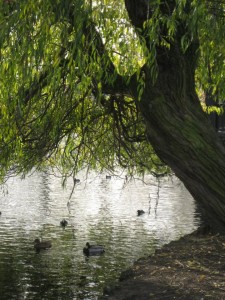Broomfield House
No one quite knows when Broomfield House first came into being.
Some say there were monastic buildings on the site in early Tudor times, and that the lakes in front of Broomfield House were ‘stews’ where fish were kept to help feed the inhabitants. Other accounts say that Broomfield House may have been a hunting lodge for James 1 while Theobalds in Enfield was being made ready.
Either way, the building is certainly ancient. According to the Broomfield House website there are elements of the building dating back to 1550 and there are records showing that John Broomfield sold land to a Geoffrey Walkden in 1566. In the Norden map of 1599, the name Palmers Green is absent, but the area to the south of the present day triangle is clearly marked as Bromefields.
Broomfield House appears to have started its life as a relatively modest two story farmhouse. The house continued to grow in the 17th century – by 1624 it had 14 hearths. The external plaster and timberwork which appears in many pictures of the building was however not original – it was added in the 1930s. The house was remodelled in the 1720s, including the addition of a new staircase and the Lanscroon murals in 1725, and again in the 1800s, possibly after its acquisition by Mr and Mrs Lybbe Powys in 1816.
After the Powyses returned to Wales the building was let to a succession of tenants, the last of which was Sir Ralph Littler, who was to have huge impact on the future of Palmers Green. It was Littler who was largely responsible for the separation of Southgate from Edmonton.
The story goes that Littler awoke one morning to find fish lying dead in the surface of the lake – sewage had seeped in from cracked pipes. There had long been dissatisfaction at the Edmonton authorities’ laxity in matters relating to the west of the district, and Littler saw red. A public meeting was called at the Schoolhouse in Powys Lane in January 1881 to vote on whether Southgate should become separate from Edmonton. A snowstorm prevented most of the Edmonton contingent from attending and the motion was carried.
Of course, thats just one side of the story. Perhaps closer to the truth is that the well-to-do residents in the west of the borough were watching the development of Edmonton very closely, as rows and rows of cheap housing filled the area – and werent too keen at the prospect of cross subsidising Edmonton’s civic needs on their rates.
Littler left Broomfield House in 1901 and the Powyses put the estate on the market. When proposals were made for public acquisition there were protests from residents who feared it would lead to a rise in rates but after a certain amount of dithering and swift action by Clerk of the Council Mr Eleanor just at the point the Powyses looked set to pull out, the house and 54 acres were bought by Southgate Urban Distict Council for £25,000. Broomfield Park received its official opening as a public park in April 1903 – an even commemorated by a shell shaped plaque near the main gates.
A museum opened in the house in 1925, including a natural history room showing plants and animals from the area and geological finds. There were also displays on local history.
This has been far from the end of its chequered history however. The house has been hit by fire on three occasions, the last of which was in 1994. It now stands swaddled in a plastic covering and scaffolding, while the council and local residents debate its possible restoration and long term fate. For an update on the campaign and how you can get involved, visit http://www.broomfieldhouse.org.uk
Broomfield Park and Gardens
The origins of the gardens are equally lost in the mists of time.
The theory about Broomfield’s possible monastic origins is alluded to above, as well as the crucial part played by the garden’s (deceased) fish in Palmers Green’s destiny. What now seems certain is that what we see at Broomfield Park are the remnants of a baroque water garden , which makes it something very special and valuable indeed.

The lakes were once part of a succession of ponds and watersplashes in the area, which were roughly all in a row. There was a pond just outside the park, at the junction of Alderman’s hill and Derwent Road, which was once very popular with small boys with fishing rods. There was also a pond, known as Littlers pond, just south of the present day park, at the junction with Powys Road and just opposite Hampton’s Farm. The boating lake near the Alderman’s Hill entrance to the park is a much more recent addition, the idea of Thomas Melville of Old Park House who served on Southgate Urban District Council for many years and was its chair during the war. It was known for some while locally as Loch Melville.
The Garden of Remembrance was opened in 1929 by Admiral of the Fleet Lord Jellicoe. The cairn in the garden is made up of 527 stones, each representing a local resident killed in the First World War. Memorials to those killed 1939-1945 were subsequently added.
The sunken playing field to the east of the building was once known as Warren Field. It was subsequently worked as a gravel pit.
More information
http://www.broomfieldhouse.org.uk/
http://friendsofbroomfieldpark.org/